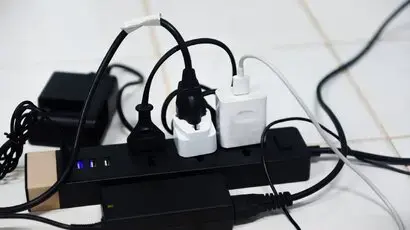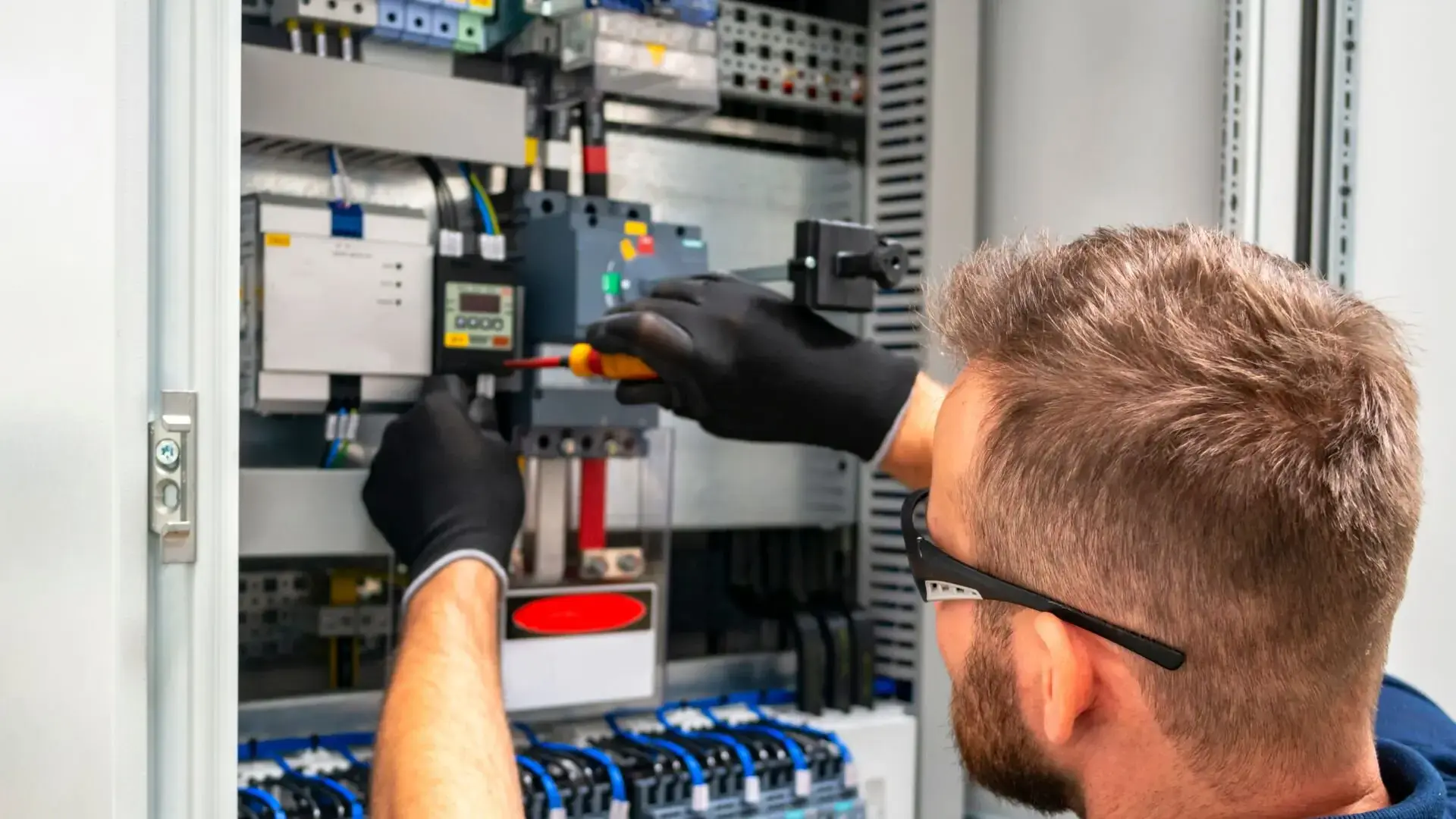
Get your free Melbourne Electrician quote today!
Our team of Melbourne Electricians is here to help you with any questions or concerns you may have. We’re committed to providing you with the best possible service and support.
Learn if surge protectors can prevent electrocution and keep your home and family safe. We’ll explain what surge protectors do, their limitations, and tips to stay safe from electric shocks in your home.
We all want our beloved gadgets and electronics to stay safe and work just right, don’t we? But let’s face it—our tech faces constant threats fromdamaging power surgesthat lurk within faulty electrical systems. A rogue surge can easily become a hazard, frying your treasured devices.
So, what’s the answer to this? High-quality surge protectors. These reliable tools defend against surges and spikes, potentially saving your gadgets from an early demise. In this guide, we’ll explore how these protectors block harmful voltages from reaching your electronics. Plus, we’ll clear up some misconceptions about their ability to protect you from electric shocks (spoiler: they don’t—that’s up to your circuit breakers).
Most importantly, we’ll guide you through smart surge protection strategies you can implement today to safeguard all your tech gear. After all, knowledge is power when it comes to preventing the catastrophe of surge-damaged devices.
You’ll be ready to arm your electrical system and send those voltage villains running by the end. Let’s banish the threat of zapped gadgets and keep your gear at peak performance.
What Is A Power Surge?
A power surge is a sudden and significant increase in voltage that can damage, deteriorate, or destroy the electronic equipment plugged into your outlets. Common causes of power surges include:
- Lightning strikes - Powerful lightning can induce sudden extreme spikes in voltage on power lines.
- Downed power lines - Fallen electrical wires and infrastructure damage lead to spikes.
- Grid/transformer issues - Problems with electrical grids and transformers can cause surges.
- Utility equipment cycling - Power returning online from outages or maintenance can surge.
- Heavy appliance cycling - Large motors/compressors turning on/off causes dips and spikes.
- Electrical accidents - Short circuits, wiring issues and electric accidents induce surges.
- EMI/RFI - Electromagnetic interference from motors, transmitters, etc, introduces spikes.
- Bad electrical wiring - Outdated, damaged or poor household wiring amplifies surges.
- Weather issues - Storms, heat waves, and cold snaps can strain electrical grids.
- Rodent damage - Rodents chewing wires lead to short circuit surges.
Power surges can inflict havoc on electrical appliances,
potentially leading to electrical fires if not
appropriately managed.The Role of Surge Protection Devices
Surge protection devices (SPDs) are designed to protect electronic equipment from excess voltage caused by power surges.
These devices divert the extra electricity from the connected devices
, preventing damage.Surge protectors work by utilising specialised internal components that rapidly detect and respond to sudden spikes in voltage.One key component is a metal oxide varistor (MOV). MOVs are designed to identify increases in voltage above normal levels. When they detect a surge, they act like a pressure release valve - instantly short-circuiting the excess electricity straight to the ground wire before it can reach your electronics.
 Surge protectors provide an additional layer of defence by diverting excess voltage before reaching connected equipment like your TV, computer or kitchen appliances. Hard-wired, whole-home surge protectors installed at your switchboard ensure all wiring and outlets have adequate protection. More vulnerable devices can also benefit from point-of-use surge strips plugged directly into wall outlets.
Surge protectors provide an additional layer of defence by diverting excess voltage before reaching connected equipment like your TV, computer or kitchen appliances. Hard-wired, whole-home surge protectors installed at your switchboard ensure all wiring and outlets have adequate protection. More vulnerable devices can also benefit from point-of-use surge strips plugged directly into wall outlets.When layered together correctly, safety switches and surge diversion technology provide robust, compliant fortification against dangerous voltage spikes. This prevents fires, equipment damage, and other electrical disasters that surges can cause.
Forworry-free protection tuned for Australian installations, have an electrician assess your situation and integrate the right surge solutions into your existing infrastructure. This provides comprehensive, seamless guarding tailored for your home and family.
The Importance of Surge Protection for Large Appliances
We rely on workhorse appliances like fridges, ovens, and air conditioners every day. But did you know cycling these heavy-duty machines on and off can send power surges back into your home’s electrical system?
When switched on, appliances’ compressors and motors draw huge bursts of current. This can stress your wiring and cause voltage spikes that damage other sensitive electronics and appliances. It becomes a vicious cycle—without protection, surges degrade appliances faster, leading to even more harmful spikes.
Large appliances benefit greatly from industrial-grade surge protectors explicitly designed for their high wattage demands. Protectors sized for air conditioner or refrigerator circuits help suppress the nasty surges they produce, allowing them to turn on smoothly. This defence also shields the units from external spikes travelling in, extending appliance lifespans.
Protecting Your Devices from Lightning
Lightning strikes can induce power surges that are catastrophic to electronic equipment. Direct lightning strike protection requires a specialised setup, as the energy involved in a lightning hit is immense. Surge protectors can offer a first line of defence, but it is often recommended to unplug sensitive electronics entirely during lightning storms.
Maintaining Your Surge Protection System
Installing surge protectors is just the first step - maintaining your system is crucial for long-term performance. While quality surge diverters are designed for years of use, they degrade over time.
Always periodically check protectors for any physical damage or scorch marks that indicate they’ve been overwhelmed. Most units have indicator lights that flicker off when components need replacing.
Additionally,routinely replace all surge suppressors every 3-5 years as an essential precaution to account for gradual wear. Don’t wait for a spike event or failure - proactively swapping depleted equipment ensures your safety net remains intact. Also, replace any protector immediately if it has blocked a significant, high-energy surge from reaching your devices - even if it still works. Its protective elements have likely used up their designed lifespan in that scenario.
Investing a few minutes in occasional inspections and routine system updates keeps your protectors in prime health. This simple maintenance lets them reliably divert hazardous voltage, preventing expensive gadget damage and potential electrical fires. Think of it like changing the oil in your car—regular proactive care means your system will keep you protected for years to come.
Protect Your Electrical Investments, and You!
Surge protectors are crucial in our day-to-day lives, shielding our homes and devices from the potential dangers of power surges. However, they’re most effective as part of a broader safety system that includes RCDs and circuit breakers to
prevent electrocution and guard against electrical faults
.Understanding and implementing the right surge protection strategy can enhance the longevity of your appliances and ensure your household’s safety.
As you contemplate the health of your home’s electrical system, consider
consulting with a professional electrician
to evaluate your surge protection needs and ensure that your setup is up to date. If you are in Melbourne, speak with our electrical experts at WP Electrical!Surge Protection FAQs
What is the difference between a residual current device (RCD) and a surge suppressor?
An RCD monitors for electrical current leakage and cuts power to prevent shocks. A surge suppressor diverts electrical surges to protect electronic equipment from voltage spikes, usually caused by events like fallen power lines. RCDs focus on human safety, while surge suppressors focus on equipment protection.
How can I tell if a power strip provides surge suppression?
Check if it’s labelled as a surge suppressor or surge protector. Suppressors contain components like metal oxide varistors that divert excess electricity. Most power strips only extend outlets without diverting surges, providing no extra protection during events causing electrical surges.
Do surge suppressors protect against power from generators?
Not necessarily. Electric generators can produce "dirty power" with more voltage spikes than standard wall outlets. Some lower-end surge suppressors may struggle with these irregular surges. Invest in industrial-grade suppressors explicitly designed for generators to ensure proper protection of electronic equipment.
My residual current device (RCD) and circuit breakers trip frequently. Do power surges cause this?
Possibly. Frequent tripping can result from electrical surges overloading wires and triggering safety devices. Surge suppressors installed at your switchboard shunt excess electricity before it reaches circuits and causes issues. Suppressors provide extra defence while letting safety features like RCDs and breakers do their core job of preventing fires and shocks.
Published by: Pascal Harb17 October 2025